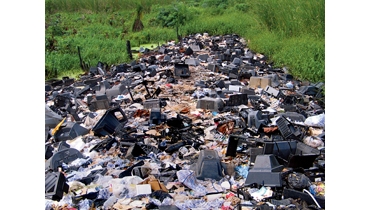Tech Trends '09: Tech Goes Green Page 2

RECYCLING
Last November, the Electronics TakeBack Coalition (ETBC) released a report card (available at takebackmytv.com) grading 17 manufacturers on their TV recycling efforts. Unfortunately, more than half of the companies failed because they don't offer a program, and of the eight that passed, only Sony received an above-average score of B-. The ETBC planned to release a new report card in February that would take into account any changes since November, including environmental-policy announcements made at this year's CES.
According to Basel Action Network (BAN), a nonprofit organization focused on waste management and fighting the trade of toxic materials, only 12.5% of all discarded electronics are recycled, and 80% of that recycled waste is exported to developing countries for processing or repurposing under lower standards than in the United States.
Tube TVs and LCD screens that use CCFL backlighting can contain toxic chemicals like lead and mercury - dangerous materials to simply burn or dump into a landfill. Even newer electronics can contain materials like PVC plastics and brominated fire retardants, which can produce toxic gases when incinerated.
Fortunately, many major electronics manufacturers are making strides in both policy and design. More and more companies are offering recycling services for their older products and are phasing out the use of toxic materials in their new products. Even retailers like Best Buy and Walmart are offering programs for old TVs and other equipment.
Newer HDTVs can be less hazardous to the environment, thanks to advances in display technology. Flat-panel screens have made CRTs and their lead-filled glass obsolete, and LED backlighting lets LCDs stay bright without using mercury-filled lamps. Many companies are also starting to phase out the use of PVCs, reducing the danger of toxic chemicals getting into the waste stream. Unfortunately, some plasma screens still use leaded glass, and many LCDs still use CCFLs, so care must still be taken in their disposal.
Sony and LG are working with WMRA, a subdivision of Waste Management, to provide free electronics recycling to their customers. At least 150 WM collection centers across the country take Sony electronics for no charge. While this isn't a huge number, each state has at least one center.
At CES 2009, Panasonic, Sharp, and Toshiba announced that they would implement a nationwide electronics take-back program with Electronic Manufacturers Recycling Management (MRM). Anyone who wants to get rid of an old Panasonic, Sharp, or Toshiba product can take it to an MRM center, where the components will be recycled for free. MRM currently has 280 centers across the country, with at least one in each state.
Samsung has been working with four recycling companies since last October, and it offers almost 200 drop-off centers across the country where you can dispose of your old Samsung electronics for free.
Even if a company claims to recycle electronics, it might not do it properly or dispose of all hazardous materials in a safe manner. Several groups are working to ensure that recycling firms are safely processing old equipment and not simply shipping them overseas to be incinerated or shredded with little or no precautions.
Greenpeace publishes the Greener Electronics Guide (available for download at greenpeace.org), which evaluates how green an electronics company's policies are. The latest guide was released last November and ranked Toshiba and Samsung comparatively high due to their phasing out of toxic materials.
BAN has introduced the e-Stewards program to make sure that recyclers are dealing with waste responsibly. While the program is currently an informal process requiring a "desk and paper audit," BAN plans to develop it into a formal certification program with third-party accreditation in 2010. One of the ETBC's criteria for its report cards is a company's commitment to using pledged e-Stewards for its recycling programs. WMRA is one of many recyclers pursuing e-Stewardship.
While ETBC, BAN, and Greenpeace aren't government entities like Energy Star, their evaluations of electronics manufacturers and retailers are some of the best ways to determine if your new gadgets are environmentally friendly. If a company scores well according to ETBC's or Greenpeace's standards, or if it employs e-Stewards for recycling its old technology, you can be confident that your new equipment (and tossed-away old gear) will be produced and disposed of responsibly.
- Log in or register to post comments



































































